
Symphyotrichum greatae is a species of flowering plant in the family Asteraceae endemic to California and known by the common name Greata's aster.

Stenotus is a genus of flowering plants in the daisy family, Asteraceae. There are four species, all native to western North America. They are known commonly as mock goldenweeds.

Pericome caudata is a species of flowering plant in the aster family known by the common name mountain tail-leaf. It is native to the southwestern United States as far east as Colorado, Oklahoma, and Texas, as well as northern Mexico, where it grows in rocky habitat, often in hills and mountains, and sometimes in disturbed areas. It is a large, branching, leafy perennial herb or subshrub approaching 2 meters in maximum height. It is glandular, resinous, sparsely hairy, and aromatic. The leaves are somewhat triangular, sometimes with a few large teeth or sharp lobes, the blade measuring up to 12 centimeters long and borne on a petiole. The leaf size and shape is variable across the species' range. The inflorescence is a cluster of many flower heads each under a centimeter wide and filled with golden yellow disc florets. The Navajo used this plant for a variety of medicinal and ceremonial purposes.

Pleurocoronis pluriseta is a species of flowering plant in the family Asteraceae known by the common name bush arrowleaf. It is native to the southwestern United States and northern Mexico, where it grows in desert scrub and similar habitat. This is a clumpy or bushy subshrub reaching up to about half a meter in maximum height with many slender branches. The distinctive leaves are several centimeters in length and are mostly petiole; there is generally a toothed diamond- or arrowhead-shaped blade no more than one centimeter long at the very tip. The inflorescence is made up of one or two flower heads, sometimes more. Each flower head is somewhat cylindrical or bullet-shaped, measuring up to about a centimeter long. The head is discoid, containing only disc florets and no ray florets. It is lined with a series of many phyllaries coated thinly in glandular hairs and often streaked with purple-red coloration. The tips of the outer phyllaries curve outward. The fruit is a hairy, ribbed achene a few millimeters long with a pappus of bristles and scales on its tip.
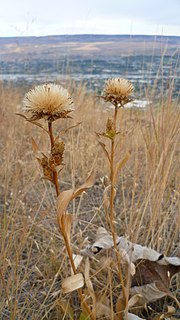
Pyrrocoma carthamoides is a species of flowering plant in the aster family known by the common name largeflower goldenweed. It is native to western North America from British Columbia to northeastern California to Wyoming, where it is known from grassland, woodlands, forests, barren areas, and other habitat. It is a perennial herb growing from a taproot and producing one or more stems to about half a meter in maximum length, the stems reddish-green and leafy. The largest leaves are at the base of the stem, measuring up to 20 centimeters long, lance-shaped with spiny sawtoothed edges. Leaves higher on the stem are smaller and hairier. The inflorescence is a single flower head or a cluster of up to four. Each bell-shaped head is lined with phyllaries each up to 2 centimeters long. It has many yellow disc florets surrounded by a fringe of yellow ray florets up to 7 millimeters long; ray florets are occasionally absent. The fruit is an achene which may be well over a centimeter in length including its pappus.

Pyrrocoma lanceolata is a species of flowering plant in the aster family known by the common name lanceleaf goldenweed. It is native to western North America from central Canada to northeastern California to Colorado, where it grows in many types of habitat, including disturbed places and areas with wet, alkali soils. It is a widespread and variable plant. It is a perennial herb growing one or more stems up to about half a meter long. The stems are decumbent or upright, reddish, usually somewhat hairy to quite woolly, and glandular toward the ends of the stems. The largest leaves are at the base of the plant, each measuring up to 30 centimeters in maximum length. They are generally lance-shaped with sawtoothed edges. The inflorescence bears several, up to 50, flower heads lined with reddish to green phyllaries. Each contains yellow disc florets and ray florets. The fruit is an achene up to a centimeter long including its pappus.
Senecio clarkianus is a species of flowering plant in the aster family known by the common name Clark's ragwort. It is endemic to the Sierra Nevada of California, where it grows in the moist meadows on the western slopes of the range. It is a perennial herb growing up to 1.2 meters tall from a caudex and fibrous root system. The solitary erect stem is lined evenly with leaves up to about 18 centimeters long, their blades deeply lobed or dissected into narrow, pointed segments. The herbage is hairy to woolly in texture. The inflorescence bears several flower heads which are lined with green-tipped phyllaries. They contain many yellow disc florets and each has usually 8 or 13 narrow yellow ray florets about a centimeter long, sometimes longer.
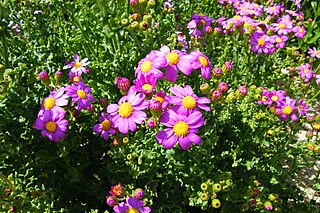
Senecio elegans is a species of flowering plant in the aster family known by the common names redpurple ragwort, purple groundsel, wild cineraria and purple ragwort.
Packera ganderi is a rare species of flowering plant in the aster family known by the common name Gander's ragwort. It is endemic to southern California, where it is known from a few occurrences in San Diego and Riverside Counties.
Packera macounii is a species of flowering plant in the aster family known by the common name Siskiyou Mountains ragwort. It is native to the west coast of North America from British Columbia to far northern California, where it grows in chaparral and mountain forests, often on serpentine soils.
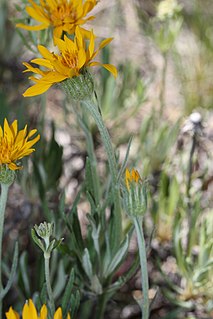
Stenotus lanuginosus is a species of flowering plant in the aster family known by the common names woolly mock goldenweed and woolly stenotus.
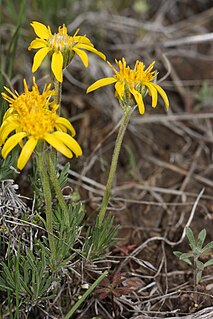
Nestotus stenophyllus is a species of flowering plant in the aster family known by the common name narrowleaf mock goldenweed. It is native to the western United States, especially the inland Pacific Northwest and northern Great Basin, where it grows in sagebrush habitat. It is a small, clump-forming perennial herb growing up to about 12 centimeters tall. The rough-haired, glandular leaves are 1 or 2 centimeters long and linear to lance-shaped. The inflorescence is a solitary flower head atop an erect peduncle. The hairy head has several yellow disc florets each around a centimeter long and at the center many yellow disc florets. The fruit is a silky-haired achene tipped with a white pappus.
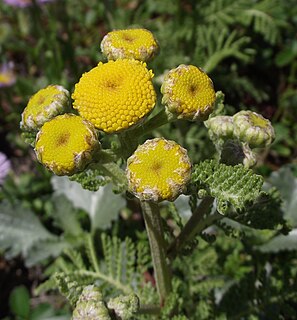
Tanacetum camphoratum is a species of flowering plant in the aster family known by the common names camphor tansy and dune tansy. It is native to the Pacific Coast of North America from British Columbia to California, where it grows in sand dunes and other coastline habitat. This species may be known by the synonym Tanacetum douglasii and is often included in Tanacetum bipinnatum. It is a rhizomatous perennial herb with a thick, low-lying stem up to 25 centimeters long, branching to form a mass of vegetation. It is hairy, glandular, and aromatic, with a camphor scent. The leaves are up to 25 centimeters long and thick but featherlike, divided into many narrow leaflets on each side of the main rachis. Each leaflet in turn has many segments along each side, and the segments are usually divided into several small, knobby segments with folded or curled edges. The inflorescence bears up to 15 flower heads, each about a centimeter wide or slightly wider. Each head contains many yellowish disc florets and many pistillate florets around the edges. The latter may have minute ray florets. The fruit is an achene a few millimeters long which is tipped with a small pappus of toothed scales.

Townsendia condensata is a species of flowering plant in the family Asteraceae known by the common names cushion Townsend daisy and cushion townsendia. It is native to North America where it is known from many scattered occurrences in the mountains of the western United States and Alberta in Canada. It is mainly limited to the alpine climates of high mountain peaks, where it grows in meadows, tundra, and barren, rocky talus. It grows alongside other alpine plants such as Eriogonum androsaceum.
Townsendia leptotes is a species of flowering plant in the family Asteraceae known by the common names common Townsend daisy and slender townsendia. It is native to the western United States, where it grows in the alpine climates of high mountain ranges from California to Montana to New Mexico.

Wyethia angustifolia is a species of flowering plant in the aster family known by the common names California compassplant and narrowleaf mule's ears. It is native to the west coast of the United States from Washington to California, where it grows in grassland, meadows, and other open habitat. It is a perennial herb growing from a tough taproot and caudex unit and producing a stem 30 to 90 centimeters tall. The leaves have lance-shaped blades up to 50 centimeters tall. The inflorescence produces one or more large sunflower-like flower heads at the top of the hairy stem. The head has narrow, hairy phyllaries at the base. It contains up to 21 yellow ray florets each up to 4.5 centimeters long and many yellow disc florets. The fruit is an achene which may be nearly 2 centimeters long including its pappus.

Wyethia glabra is a species of flowering plant in the aster family known by the common name Coast Range mule's ears. It is endemic to California, where it grows in the North and Central Coast Ranges. It is a perennial herb growing from a tough taproot and caudex unit and producing a stem up to 40 centimeters tall. It is hairless to hairy and glandular. The leaves have lance-shaped or oval blades up to 45 centimeters long. The inflorescence is usually a solitary flower head or occasionally a cluster of 2 or more. The head has lance-shaped leaflike phyllaries at the base. It contains up to 21 yellow ray florets each up to 5 centimeters long and many yellow disc florets. The fruit is an achene over a centimeter long, including its pappus.
Agnorhiza ovata is a species of flowering plant known by the common name southern mule's ears. It is native to the mountains and foothills of southern California and Baja California, occurring the Coast Ranges and Sierra Nevada foothills in Tulare, Kern, Ventura, Los Angeles, Orange, Riverside, and San Diego counties in California, with additional populations in the Peninsular Ranges south of the international border.
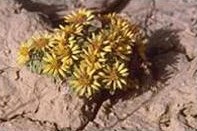
Townsendia aprica is a rare species of flowering plant in the family Asteraceae known by the common name Last Chance Townsend daisy. It is endemic to Utah in the United States, where it is known from three counties. It faces a number of threats and it is a federally listed threatened species of the United States.
Erigeron hessii is a rare species of flowering plant in the aster family known by the common name Hess' fleabane. It is endemic to New Mexico in the United States, where it is known from two locations in the Mogollon Mountains. It is found only in the Gila Wilderness.














